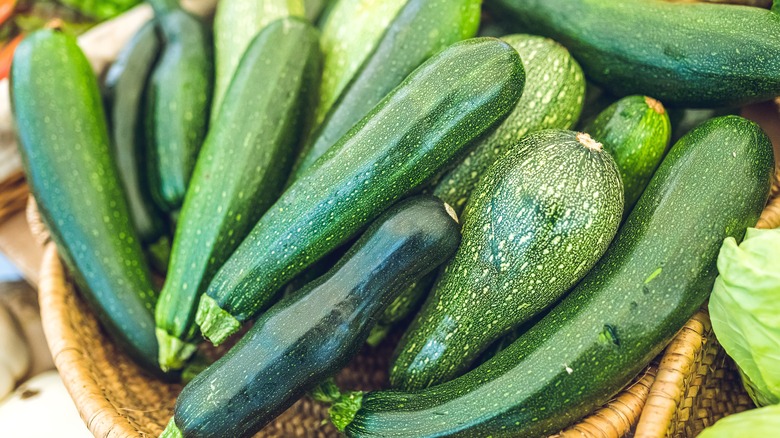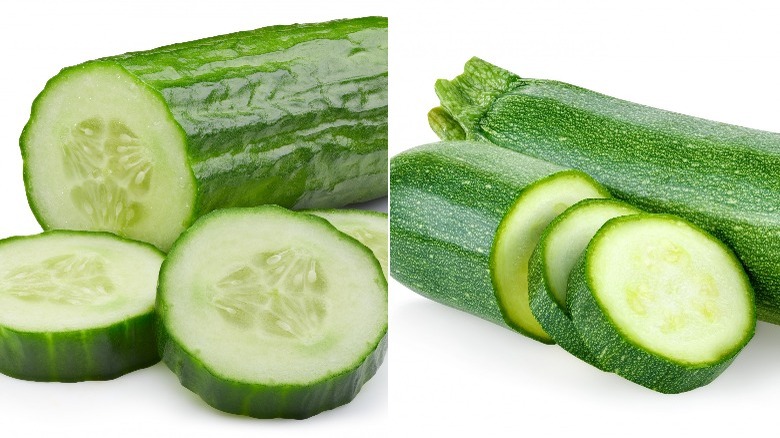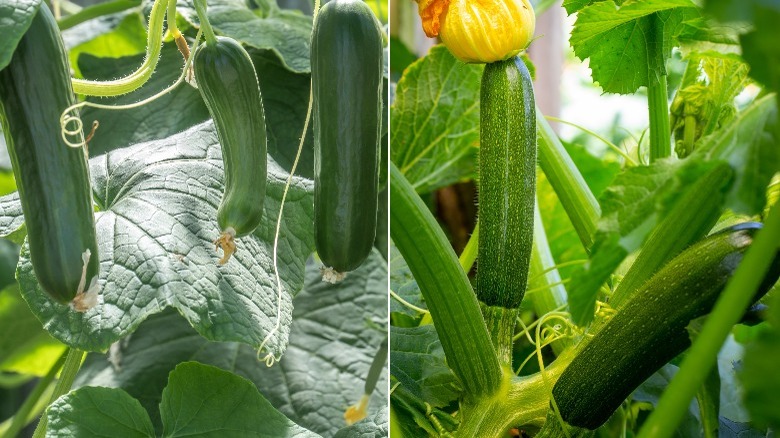What's The Difference Between A Cucumber And A Zucchini?
We may receive a commission on purchases made from links.
If you've just learned how to differentiate a yam from a sweet potato, here's another puzzle for you. What's the difference between a cucumber and a zucchini? The similarities are easy to spot. They're both long and green with whitish innards, they both hang out in your supermarket's produce section, and MasterClass reveals that they are both gourds.
In the United States, the cucumber is more familiar than the zucchini. The Wilson Center reveals that the average U.S. resident eats roughly 12 pounds of cucumbers each year, enabling it to take the seventh-highest spot in Statista's list of the nation's most consumed fresh vegetables in 2021. Zucchini doesn't even make the list. In fact, Fox News adds that a survey of 2,000 Americans conducted by OnePoll listed the humble zucchini as the country's eighth most hated vegetable, with 18% of people saying they don't like to eat it. How can two products look so much alike but generate such disparate reactions from America's taste buds?
The truth is that the cucumber and the zucchini are not as similar as some may think. They are about as different as Croatian cucumber salad and zucchini bread muffins.
Cucumbers and zucchinis have different textures
Yes, they share both a common hue and shape, but there are a few obvious differences between the look of a cucumber (pictured on the left) and a zucchini (on the right). For one thing, MasterClass explains that the zucchini has a thick, wood stem on one end, while the cucumber does not. Furthermore, when you slice into your matching green oblongs, you will notice that the zucchini's innards are pure white, but the cucumber's are white with a "pale green tinge." Plus, the seeds of the cucumber are larger and more obvious.
If you've ever bitten into a cucumber or a zucchini, you'll know that their textures and tastes are distinct as well. The cucumber is crisp and juicy, but the zucchini has a somewhat bitter taste. Plus, the cucumber feels cooler to the touch. Clearly, the adage cool as a cucumber exists for a reason. Zucchini can be eaten raw or cooked, while cucumbers tend to be consumed solely in raw form. As Seinfeld's Poppie once told a disgruntled Kramer, "You can't put cucumbers on pizza." Unless, of course, you can master Martha Stewart's sautéed cucumber recipe or Julia Child's baked cucumbers at Food. Cooked cucumbers. Who knew?
Cucumbers and zucchinis require different storage methods
While both are gourds, MasterClass explains that the zucchini plant, unlike the cucumber, is part of the cucurbita pepo family, like pumpkins and squashes. They also grow differently. Both plants have big leaves that resemble hearts, but the cucumbers (pictured left) dangle from their plant. The zucchinis (on the right) grow off the stem as if they were a part of the plant.
They also appear to prefer different storage techniques. Southern Living recommends keeping your cucumber at room temperature, eschewing the refrigerator in order to avoid chilling injuries that could cause them to rot prematurely. Zucchini, however, can live in your fridge's crisper drawer for up to four or five days, providing that you don't wash it until you're ready to use it. And another noteworthy difference between the two, according to FoodStruct, is that the serving size for a cucumber is half a cup, while the zucchini's is a full cup.
You are now fully versed on how to tell cucumbers and zucchinis apart. Never again will you attempt to make baked zucchini sticks with a cucumber.


